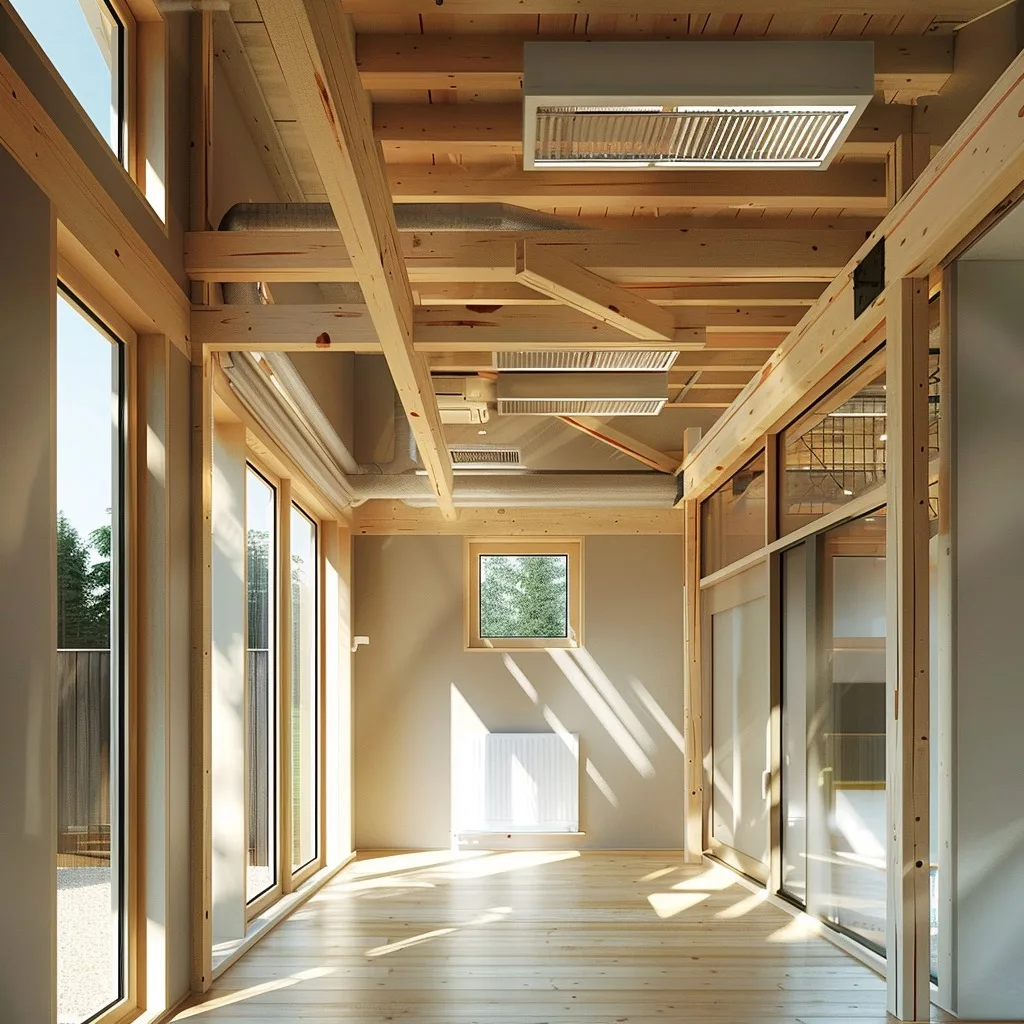Optimizing Indoor Air Quality and Comfort in Insulated, Airtight Buildings
In modern, energy-efficient buildings, achieving both airtightness and proper ventilation is crucial for maintaining indoor air quality and thermal comfort. Airtightness prevents uncontrolled air leakage, which can lead to drafts, energy losses, and moisture-related issues like condensation and mould. However, airtightness alone is not enough – a well-designed ventilation system is necessary to ensure a continuous supply of fresh air and removal of stale, polluted air.
The Importance of Balanced Ventilation
In an airtight building, relying on uncontrolled air leakage for ventilation is not an option. Instead, a balanced mechanical ventilation system should be installed, typically in the form of a Heat Recovery Ventilation (HRV) or Energy Recovery Ventilation (ERV) unit. These systems continuously supply fresh outdoor air while exhausting stale indoor air, with the incoming and outgoing air streams passing through a heat exchanger to recover energy and improve efficiency. Properly sizing and commissioning the ventilation system is critical. Insufficient ventilation can lead to poor indoor air quality, while over-ventilation wastes energy and may cause comfort issues like drafts. Ventilation rates should be based on the size of the building, number of occupants, and local code requirements.
Ensuring Airtightness and Ventilation Work Together
For the ventilation system to function effectively, the building envelope must be airtight. Any uncontrolled air leakage paths will compromise the system’s performance and may lead to comfort and moisture issues. Careful attention must be paid to sealing all potential air leakage points, such as around windows, doors, electrical outlets, and ductwork penetrations. It’s also important to ensure that the ventilation system is properly balanced, with the correct supply and exhaust airflows in each room. Imbalances can lead to pressure differences that drive uncontrolled air movement and undermine the airtightness of the building envelope.
Ventilation Strategies for Different Building Types
The specific ventilation strategy will depend on the building type and occupancy. In residential buildings, a central HRV or ERV system is common, with ductwork distributing air to each room. In larger buildings like offices or schools, a central air handling unit may serve multiple zones, with local terminal units providing fine control of temperature and airflow in each space. In some cases, a hybrid approach may be used, combining central mechanical ventilation with operable windows for natural ventilation. This allows occupants to take advantage of mild outdoor conditions while still maintaining good indoor air quality and comfort.
Natural Alternatives to HVAC Systems
In insulated, airtight buildings, increased humidity levels can be a significant issue due to reduced air circulation and inadequate moisture removal. This trapped humidity can lead to mould growth, dust mite infestations, and other indoor air quality problems. To mitigate high humidity in these types of buildings, a balanced mechanical ventilation system is crucial.
Balanced Mechanical Ventilation
The most effective solution is to install a Heat Recovery Ventilation (HRV) or Energy Recovery Ventilation (ERV) system. These systems continuously supply fresh outdoor air while exhausting stale, humid indoor air, with the incoming and outgoing air streams passing through a heat exchanger to recover energy and improve efficiency. Proper sizing and commissioning of the ventilation system is critical to ensure adequate airflow without over-ventilating and wasting energy.
Passive Cooling Strategies
In addition to mechanical ventilation, there are several passive cooling strategies that can help regulate temperature and humidity in insulated, airtight buildings:
Passive Solar Design
Orienting the building to maximize exposure to natural sunlight during the winter and minimize it during the summer can reduce cooling and heating loads. Strategically placed windows, overhangs, and thermal mass can help passively regulate indoor temperatures.
Natural Ventilation
Operable windows, vents, and strategically placed openings can allow for natural cross-ventilation, using outdoor breezes to cool the indoor space. This can be combined with the mechanical ventilation system for a hybrid approach.
Evaporative Cooling
In dry climates, evaporative coolers (also known as “swamp coolers”) can provide an energy-efficient alternative to traditional air conditioning. These systems use the evaporation of water to cool the air, consuming far less energy than vapor-compression systems.
Geothermal Heat Pumps
Ground-source heat pumps, which use the relatively constant temperature of the earth or groundwater as a heat source or sink, can provide both heating and cooling in an efficient, sustainable manner. These systems are well-suited for insulated, airtight buildings.
By combining a balanced mechanical ventilation system with passive cooling strategies, it is possible to maintain good indoor air quality and thermal comfort in insulated, airtight buildings without relying solely on energy-intensive HVAC equipment.
Conclusion
Achieving good indoor air quality and thermal comfort in insulated, airtight buildings requires a well-designed ventilation system that works in harmony with the building envelope. Airtightness prevents uncontrolled air leakage, which can lead to drafts, energy losses, and moisture-related issues like condensation and mould. However, airtightness alone is not enough; a balanced mechanical ventilation system, typically in the form of a Heat Recovery Ventilation (HRV) or Energy Recovery Ventilation (ERV) unit, is necessary to ensure a continuous supply of fresh air and removal of stale, polluted air. Properly sizing and commissioning this system is critical to ensure adequate airflow without over-ventilating and wasting energy.
Solar-powered HVAC systems for NZED building
Over the past decade, solar-powered HVAC systems have made significant strides, particularly for small homes. This progress has been driven by the introduction of 48V solar systems, which are now commonly found in high-end recreational vehicles (RVs).These solar-powered HVAC systems can run from 48v DC and have become an effective way to heat and cool RVs and small buildings using renewable energy.
Utilize Solar Thermal Collectors for Heating
Install solar thermal collectors on the roof to absorb heat from the sun and transfer it to a fluid, which can then be used to heat air or water system.
Solar thermal systems are highly efficient at converting sunlight into usable heat energy for space heating and domestic hot water.
Incorporate Thermal Energy Storage
Use thermal energy storage tanks or phase change materials to store excess heat generated by the solar thermal system during the day for use at night or on cloudy days.
Thermal storage allows the HVAC system to operate more consistently and reduces the need for backup heating.
Optimize Building Design for Solar
Orient the building to maximize exposure to the sun during winter months and minimize it during summer.
Use passive solar design features like south-facing windows, thermal mass, and overhangs to reduce heating and cooling loads.
Ensure the building envelope is highly insulated and airtight to minimize heat loss and gain.
Integrate with Photovoltaic Solar
Use photovoltaic solar panels to generate electricity to power the HVAC system’s fans, pumps, and controls is possible providing they are correctly sized instalations.
Excess electricity generated can be used to power other building or put into energy storage devices.
By combining solar thermal heating, ground source tubes, thermal energy storage, passive solar design, and photovoltaic solar, it is possible to create a highly efficient, zero-energy HVAC system for NZED buildings. This approach reduces reliance on fossil fuels and provides a sustainable solution for heating and cooling.

